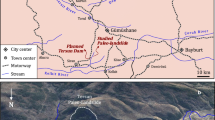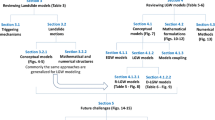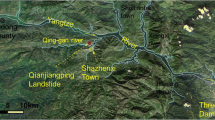Abstract
This study used 3D numerical simulations to model the potential risk of impulse waves originating from concurrent landslides in Çetin Dam Reservoir in Southeast Turkey, which is near an active orogenic belt and related uplift system. A volume of fluid (VOF) model based on the Reynolds averaged Navier–Stokes equations was used to accurately simulate the free-surface/solid interaction, landslide deformation, and wave propagation. A renormalization group (RNG)-based k-ε turbulence model was used to create a fluid coupled model, and a drift-flux model was selected to simulate the potential landslide. A partially submerged landslide located 4900 m from the dam and another subaerial landslide located 800 m from dam were first modelled separately. 3D numerical models show that the impulse wave triggered by the subaerial landslide reaches 4 m in height at 34 s right in front of the dam, whereas the wave induced by the partially submerged landslide reaches 4.2 m in height at 205 s. After the effects of both landslides were modelled separately, the cumulative effect of impulse waves was evaluated in the case of the two landslides occurring simultaneously. As predicted, the highest wave reaching the dam body occurred 15 s later due to the interference of the two waves. However, contrary to expectations, the height of the new wave increased, which was probably due to the constructive interference of the original waves, and it reached 5.6 m at the dam body. Numerical analysis shows that when more than one landslide occurs simultaneously in the reservoir, the resulting interference affects the wave properties considerably.









Similar content being viewed by others
References
Abdollahi A, Mason HB (2019) Tsunami-induced pore water pressure response of unsaturated soil beds: numerical formulation and experiments. Comput Geotech 110:19–27. https://doi.org/10.1016/j.compgeo.2019.02.012
Açıkbaş D, Akgül A, Erdoğan LT (1981) Güneydoğu Anadolu’nun hidrokarbon olanakları ve Baykan-Şirvan-Pervari yöresinin jeolojisi. TPAO Report, Ankara (in Turkish)
Bazykina AY, Mikhailichenko SY, Fomin VV (2018) Numerical simulation of tsunami in the Black Sea caused by the earthquake on September 12, 1927. Phys Oceanogr 25:295–304. https://doi.org/10.22449/1573-160x-2018-4-295-304
Bonaccorso A, Calvari S, Garfi G et al (2003) Dynamics of the December 2002 flank failure and tsunami at Stromboli volcano inferred by volcanological and geophysical observations. Geophys Res Lett 30:1–4. https://doi.org/10.1029/2003GL017702
Bregoli F, Bateman A, Medina V (2017) Tsunamis generated by fast granular landslides: 3D experiments and empirical predictors. J Hydraul Res 55:743–758. https://doi.org/10.1080/00221686.2017.1289259
Brethour JM, Hirt CW (2009) Drift model for two-component flows. Flow Sci Inc 1–7
Choudhury D (1973) Introduction to the renormalization group method and turbulence modeling. Fluent Incorporated
Day S, Llanes P, Silver E et al (2015) Submarine landslide deposits of the historical lateral collapse of Ritter Island, Papua New Guinea. Mar Pet Geol 67:419–438. https://doi.org/10.1016/j.marpetgeo.2015.05.017
De-Girolamo P, Cecioni C, Montagna F et al (2009) Numerical modelling of landslide generated tsunamis around a Conical Island. In: Proceedings of the Coastal Engineering Conference, pp 1287–1299
Di Risio M, De Girolamo P, Bellotti G et al (2009) Landslide-generated tsunamis runup at the coast of a conical island: new physical model experiments. J Geophys Res Ocean 114:1–16. https://doi.org/10.1029/2008JC004858
Ersoy H, Karahan M, Gelişli K et al (2019) Modelling of the landslide-induced impulse waves in the Artvin Dam reservoir by empirical approach and 3D numerical simulation. Eng Geol 249:112–128. https://doi.org/10.1016/j.enggeo.2018.12.025
Ersoy H, Karahan M, Öztürk HH (2020) Baraj Rezervuarlarında Heyelanlardan Kaynaklanacak İtki Dalga Özelliklerinin Ampirik İlişkilerle Değerlendirilmesi: Borçka Barajı Örneği. DOAD 6:248–257. https://doi.org/10.21324/dacd.621377 (in Turkish with English abstract)
Evers FM, Hager WH (2015) Impulse wave generation: comparison of free granular with mesh-packed slides. J Mar Sci Eng 3:100–110. https://doi.org/10.3390/jmse3010100
Franco A, Moernaut J, Schneider-Muntau B, Strasser M, Gems B (2021a) Triggers and consequences of landslide-induced impulse waves–3D dynamic reconstruction of the Taan Fiord 2015 tsunami event. Eng Geol 294:106384. https://doi.org/10.1016/j.enggeo.2021.106384
Franco A, Schneider-Muntau B, Roberts NJ, Clague JJ, Gems B (2021b) Geometry-based preliminary quantification of landslide-ınduced ımpulse wave attenuation in mountain lakes. Appl Sci 11:11614. https://doi.org/10.3390/app112411614
Fritz HM, Hager WH, Minor HE (2004) Near field characteristics of landslide generated impulse waves. J. Waterw. Port. Coast Ocean Eng 130:287–302
Fritz HM, Mohammed F, Yoo J (2009) Lituya bay landslide impact generated mega-tsunami 50th anniversary. In: Cummins PR, Satake K, Kong LSL (eds) Tsunami science four years after the 2004 Indian Ocean Tsunami. Pageoph Topical Volumes. Birkhäuser, Basel. https://doi.org/10.1007/978-3-0346-0064-4_9
Gabl R, Seibl J, Gems B, Aufleger M (2015) 3-D numerical approach to simulate the overtopping volume caused by an impulse wave comparable to avalanche impact in a reservoir. Nat Hazards Earth Syst Sci 15:2617–2630. https://doi.org/10.5194/nhess-15-2617-2015
Grilli ST, Vogelmann S, Watts P (2002) Development of a 3D numerical wave tank for modeling tsunami generation by underwater landslides. Eng Anal Bound Elem 26:301–313. https://doi.org/10.1016/S0955-7997(01)00113-8
Heller V (2007) Landslide generated impulse waves: prediction of near field characteristics. ETH Zurich, Zürich (Dissertation)
Heller V, Bruggemann M, Spinneken J, Rogers BD (2016) Composite modelling of subaerial landslide-tsunamis in different water body geometries and novel insight into slide and wave kinematics. Coast Eng 109:20–41. https://doi.org/10.1016/j.coastaleng.2015.12.004
Heller V, Hager WH (2010) Impulse product parameter in landslide generated impulse waves. J Waterw Port, Coast Ocean Eng 136:145–155. https://doi.org/10.1061/(ASCE)WW.1943-5460.0000037
Heller V, Hager WH, Minor HE (2009) Landslide generated impulse waves in reservoirs: Basics and computation. Mitteilungen der Versuchsanstalt fur Wasserbau, Hydrol und Glaziologie an der Eidgenoss Tech Hochschule Zurich 1–172
Hendron AJ, Patton FD (1987) The vaiont slide - a geotechnical analysis based on new geologic observations of the failure surface. Eng Geol 24:475–491. https://doi.org/10.1139/t87-023
Hibiki T, Ishii M (2003) One-demensional drift-flux model for two-phase flow in a large diameter pipe. Int J Heat Mass Transf 46:1773–1790. https://doi.org/10.1016/S0017-9310(02)00473-8
Huang BL, Wang SC (2017) Wave attenuation mechanism of cross-plates applied in landslide-induced tsunami in river course. J Mt Sci 14:649–661. https://doi.org/10.1007/s11629-016-4218-6
Hughes SA (1993) Physical models and laboratory techniques in coastal engineering. World Scientific
Kafle J, Tuladhar BM (2018) Landslide-water interaction for partially submerged landslide. J Nepal Math Soc 1:22–29
Karahan M, Ersoy H, Akgun A (2020a) A 3D numerical simulation-based methodology for assessment of landslide-generated impulse waves: a case study of the Tersun Dam reservoir (NE Turkey). Landslides 17:2777–2794. https://doi.org/10.1007/s10346-020-01440-4
Karahan M, Ersoy H, Anilan T (2020b) İtki dalgalarının oluşumunda ölçek etkisi, hareket süresi ve çarpma hızının model deneyler ve 3 boyutlu nümerik simülasyonlarla değerlendirilmesi (in Turkish with English abstract). GUFBED 10:514–525
Kesseler M, Heller V, Turnbull B (2018) A laboratory-numerical approach for modelling scale effects in dry granular slides. Landslides 15:2145–2159. https://doi.org/10.1007/s10346-018-1023-z
Kim G-B (2012) Numerical simulation of three-dimensional tsunami generation by subaerial landslides. Texas A&M University (Dissertation)
Kocaman S, Ozmen-Cagatay H (2015) Investigation of dam-break induced shock waves impact on a vertical wall. J Hydrol 525:1–12. https://doi.org/10.1016/j.jhydrol.2015.03.040
Li G, Chen G, Li P, Jing H (2019) Efficient and accurate 3-D numerical modelling of landslide Tsunami. Water (switzerland) 11:1–17. https://doi.org/10.3390/w11102033
Li DQ, Ding YN, Tang XS, Liu Y (2021a) Probabilistic risk assessment of landslide-induced surges considering the spatial variability of soils. Eng Geol 283:105976. https://doi.org/10.1016/j.enggeo.2020.105976
Li Y, Pang R, Xu B, Wang X, Fan Q, Jiang F (2021b) GPDEM-based stochastic seismic response analysis of high concrete-faced rockfill dam with spatial variability of rockfill properties based on plastic deformation. Comput Geotech 139:104416. https://doi.org/10.1016/j.compgeo.2021.104416
Liu PLF, Wu TR, Raichlen F et al (2005) Runup and rundown generated by three-dimensional sliding masses. J Fluid Mech 536:107–144. https://doi.org/10.1017/S0022112005004799
Montagna F, Bellotti G, Di Risio M (2011) 3D numerical modeling of landslide-generated tsunamis around a conical island. Nat Hazards 58:591–608. https://doi.org/10.1007/s11069-010-9689-0
Pang R, Xu B, Kong X, Zhou Y, Zou D (2018) Seismic performance evaluation of high CFRD slopes subjected to near-fault ground motions based on generalized probability density evolution method. Eng Geol 246:391–401. https://doi.org/10.1016/j.enggeo.2018.09.004
Pang R, Xu B, Zhou Y, Song L (2021) Seismic time-history response and system reliability analysis of slopes considering uncertainty of multi-parameters and earthquake excitations. Comput Geotech 136:104245. https://doi.org/10.1016/j.compgeo.2021.104245
Perinçek D (1980) IX. Bölge Hakkâri-Yüksekovaçukurca-Beytüşşebap-Uludere-Pervari dolayının jeolojisi. TPAO Report, Ankara (in Turkish)
Perinçek D (1990) Hakkari ili ve dolayının stratigrafisi, GDA Türkiye (in Turkish). Bull Turk Assoc Pet Geol 2:21–68
Perinçek D (2016) Cetin Baraj Gövdesi ve Dolayinin Jeolojisi ve Heyelan Araştırmasi. Türkiye Jeol Bülteni 59:167–210
Perinçek D, Günay Y, Kozlu H (1987) New observation on strike-slip faults in east and southeast Anatolia. In: 7th Biannual Petroleum Congress of Turkey, Ankara
Quecedo M, Pastor M, Herreros MI (2004) Numerical modelling of impulse wave generated by fast landslides. Int J Numer Methods Eng 59:1633–1656. https://doi.org/10.1002/nme.934
Shen Y, Whittaker CN, Lane EM, Power W, Melville BW (2022) Interference effect on tsunami generation by segmented seafloor deformations. Ocean Eng 245:110244. https://doi.org/10.1016/j.oceaneng.2021.110244
Shi C, An Y, Wu Q et al (2016) Numerical simulation of landslide-generated waves using a soil-water coupling smoothed particle hydrodynamics model. Adv Water Resour 92:130–141. https://doi.org/10.1016/j.advwatres.2016.04.002
Smith RC, Hill J, Collins GS et al (2016) Comparing approaches for numerical modelling of tsunami generation by deformable submarine slides. Ocean Model 100:125–140. https://doi.org/10.1016/j.ocemod.2016.02.007
Spesivtsev P, Sinkov K, Osiptsov A (2013) Comparison of drift-flux and multi-fluid approaches to modeling of multiphase flow in oil and gas wells. In: WIT Transactions on Engineering Sciences, pp 89–99
Tolun N (1954) Güneydoğu Anadolu’nun stratigrafisi ve tektoniği. MTA Report, Ankara (in Turkish)
Utmanoğulları M (2012) Geology, subsurface geology and hydrocarbon possibilities of around of Şirvan Özpınar (Siirt). Çanakkale Onsekiz Mart University (Dissertation)
Vacondio R, Mignosa P, Pagani S (2013) 3D SPH numerical simulation of the wave generated by the vajont rockslide. Adv Water Resour 59:146–156. https://doi.org/10.1016/j.advwatres.2013.06.009
Wang J, Ward SN, Xiao L (2019) Tsunami Squares modeling of landslide generated impulsive waves and its application to the 1792 Unzen-Mayuyama mega-slide in Japan. Eng Geol 256:121–137. https://doi.org/10.1016/j.enggeo.2019.04.020
Wang D, Wang Z, Li Y et al (2020) Characteristics and dynamic process analysis of the 2018 Mabian consequent landslide in Sichuan Province, China. Bull Eng Geol Environ 79:3337–3359. https://doi.org/10.1007/s10064-020-01784-0
Wang W, Chen G, Yin K et al (2015) Modeling of landslide generated waves in Three Gorges Reservoir, China using SPH method. In: 15th Asian Regional Conference on Soil Mechanics and Geotechnical Engineering, ARC 2015: New Innovations and Sustainability, pp 1183–1188
Xu WJ, Yao ZG, Luo YT, Dong XY (2020) Study on landslide-induced wave disasters using a 3D coupled SPH-DEM method. Bull Eng Geol Environ 79:467–483. https://doi.org/10.1007/s10064-019-01558-3
Xu WJ, Wang YJ, Dong XY (2021) Influence of reservoir water level variations on slope stability and evaluation of landslide tsunami. Bull Eng Geol Environ 80:4891–4907. https://doi.org/10.1007/s10064-021-02218-1
Yavari-Ramshe S, Ataie-Ashtiani B (2016) Numerical modeling of subaerial and submarine landslide-generated tsunami waves–recent advances and future challenges. Landslides 13:1325–1368. https://doi.org/10.1007/s10346-016-0734-2
Yin YP, Huang B, Chen X et al (2015) Numerical analysis on wave generated by the Qianjiangping landslide in Three Gorges Reservoir, China. Landslides 12:355–364. https://doi.org/10.1007/s10346-015-0564-7
Yılmaz Y, Yiğitbaş E (1990) GD Anadolu’nun farklı ofiyolitik-metamorfik birlikleri ve bunların jeolojik evrimdeki rolü (in Turkish). Türkiye 8:128–140
Zhang T, Yan E, Cheng J, Zheng Y (2010) Mechanism of reservoir water in the deformation of Hefeng landslide. J Earth Sci 21:870–875. https://doi.org/10.1007/s12583-010-0139-4
Zhang Y, Li D, Chen L et al (2020) Numerical analysis of landslide-generated impulse waves affected by the reservoir geometry. Eng Geol 266:1–15. https://doi.org/10.1016/j.enggeo.2019.105390
Zhao T, Utili S, Crosta GB (2016) Rockslide and ımpulse wave modelling in the Vajont Reservoir by DEM-CFD analyses. Rock Mech Rock Eng 49:2437–2456. https://doi.org/10.1007/s00603-015-0731-0
Author information
Authors and Affiliations
Corresponding author
Ethics declarations
Conflict of interest
The authors declare no competing interests.
Additional information
Publisher’s Note
Springer Nature remains neutral with regard to jurisdictional claims in published maps and institutional affiliations.
Rights and permissions
About this article
Cite this article
Ersoy, H., Oğuz Sünnetci, M., Karahan, M. et al. 3D simulations of impulse waves originating from concurrent landslides near an active fault using FLOW-3D software: a case study of Çetin Dam Reservoir (Southeast Turkey). Bull Eng Geol Environ 81, 267 (2022). https://doi.org/10.1007/s10064-022-02738-4
Received:
Accepted:
Published:
DOI: https://doi.org/10.1007/s10064-022-02738-4




